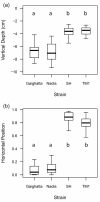Brain transcriptome variation among behaviorally distinct strains of zebrafish (Danio rerio)
- PMID: 22817472
- PMCID: PMC3434030
- DOI: 10.1186/1471-2164-13-323
Brain transcriptome variation among behaviorally distinct strains of zebrafish (Danio rerio)
Abstract
Background: Domesticated animal populations often show profound reductions in predator avoidance and fear-related behavior compared to wild populations. These reductions are remarkably consistent and have been observed in a diverse array of taxa including fish, birds, and mammals. Experiments conducted in common environments indicate that these behavioral differences have a genetic basis. In this study, we quantified differences in fear-related behavior between wild and domesticated zebrafish strains and used microarray analysis to identify genes that may be associated with this variation.
Results: Compared to wild zebrafish, domesticated zebrafish spent more time near the water surface and were more likely to occupy the front of the aquarium nearest a human observer. Microarray analysis of the brain transcriptome identified high levels of population variation in gene expression, with 1,749 genes significantly differentially expressed among populations. Genes that varied among populations belonged to functional categories that included DNA repair, DNA photolyase activity, response to light stimulus, neuron development and axon guidance, cell death, iron-binding, chromatin reorganization, and homeobox genes. Comparatively fewer genes (112) differed between domesticated and wild strains with notable genes including gpr177 (wntless), selenoprotein P1a, synaptophysin and synaptoporin, and acyl-CoA binding domain containing proteins (acbd3 and acbd4).
Conclusions: Microarray analysis identified a large number of genes that differed among zebrafish populations and may underlie behavioral domestication. Comparisons with similar microarray studies of domestication in rainbow trout and canids identified sixteen evolutionarily or functionally related genes that may represent components of shared molecular mechanisms underlying convergent behavioral evolution during vertebrate domestication. However, this conclusion must be tempered by limitations associated with comparisons among microarray studies and the low level of population-level replication inherent to these studies.
Figures


References
-
- Price EO. In: Genetics and the behavior of domestic animals. Grandin T, editor. San Diego, Academic Press; 1998. Behavioral genetics and the process of animal domestication; pp. 41–65.
-
- Price EO. Behavioral development in animals undergoing domestication. Applied Animal Behaviour Science. 1999;65(3):245–271.
-
- Waples RS. Dispelling some myths about hatcheries. Fisheries. 1999;24(2):12–21.
-
- Devlin RH, Biagi CA, Yesaki TY, Smailus DE, Byatt JC. Growth of domesticated transgenic fish. Nature. 2001;409(6822):781–782. - PubMed
-
- Fleming IA, Agustsson T, Finstad B, Johnsson JI, Björnsson BT. Effects of domestication on growth physiology and endocrinology of Atlantic salmon (Salmo salar) Can J Fish Aquat Sci. 2002;59(8):1323–1330.
Publication types
MeSH terms
Substances
Grants and funding
LinkOut - more resources
Full Text Sources
Molecular Biology Databases
Research Materials

